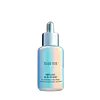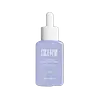What's inside
What's inside
 Key Ingredients
Key Ingredients

 Benefits
Benefits

 Concerns
Concerns

 Ingredients Side-by-side
Ingredients Side-by-side

Water
Skin ConditioningButylene Glycol
HumectantPentylene Glycol
Skin ConditioningPropanediol
SolventGlycerin
HumectantHexylene Glycol
EmulsifyingPhenoxyethanol
PreservativeCarbomer
Emulsion StabilisingAcetamide Mea
HumectantPhyllanthus Emblica Fruit Extract
HumectantNiacinamide
SmoothingAminomethyl Propanol
BufferingKappaphycus Alvarezii Extract
Skin ConditioningPanthenol
Skin ConditioningCaffeine
Skin ConditioningEthylhexylglycerin
Skin ConditioningArginine
MaskingLactic Acid
BufferingAmaranthus Caudatus Seed Extract
Skin ConditioningDisodium EDTA
Pinus Pinaster Bark Extract
AntioxidantGlycine Soja Germ Extract
EmollientTriticum Vulgare Germ Extract
Skin ConditioningSea Water
HumectantSodium Benzoate
MaskingGluconolactone
Skin ConditioningHydrolyzed Rice Protein
Skin ConditioningScutellaria Baicalensis Root Extract
AstringentPPG-26-Buteth-26
Skin Conditioning1,2-Hexanediol
Skin ConditioningSerenoa Serrulata Fruit Extract
Skin ConditioningPEG-40 Hydrogenated Castor Oil
EmulsifyingSh-Polypeptide-123
Skin ProtectingPotassium Sorbate
PreservativeHydrolyzed Yeast Protein
Skin ConditioningApigenin
AntioxidantCalcium Gluconate
HumectantOleanolic Acid
Skin ConditioningBiotinoyl Tripeptide-1
Water, Butylene Glycol, Pentylene Glycol, Propanediol, Glycerin, Hexylene Glycol, Phenoxyethanol, Carbomer, Acetamide Mea, Phyllanthus Emblica Fruit Extract, Niacinamide, Aminomethyl Propanol, Kappaphycus Alvarezii Extract, Panthenol, Caffeine, Ethylhexylglycerin, Arginine, Lactic Acid, Amaranthus Caudatus Seed Extract, Disodium EDTA, Pinus Pinaster Bark Extract, Glycine Soja Germ Extract, Triticum Vulgare Germ Extract, Sea Water, Sodium Benzoate, Gluconolactone, Hydrolyzed Rice Protein, Scutellaria Baicalensis Root Extract, PPG-26-Buteth-26, 1,2-Hexanediol, Serenoa Serrulata Fruit Extract, PEG-40 Hydrogenated Castor Oil, Sh-Polypeptide-123, Potassium Sorbate, Hydrolyzed Yeast Protein, Apigenin, Calcium Gluconate, Oleanolic Acid, Biotinoyl Tripeptide-1
Water
Skin ConditioningButylene Glycol
HumectantGlycerin
HumectantPropanediol
SolventPanthenol
Skin ConditioningCeramide AP
Skin Conditioning1,2-Hexanediol
Skin ConditioningCaffeine
Skin ConditioningTrisodium Ethylenediamine Disuccinate
PPG-26-Buteth-26
Skin ConditioningPEG-40 Hydrogenated Castor Oil
EmulsifyingCaprylhydroxamic Acid
Sorbitol
HumectantLactic Acid
BufferingCocos Nucifera Oil
MaskingXanthan Gum
EmulsifyingCeratonia Siliqua Gum
EmollientLarix Europaea Wood Extract
HumectantGlycine
BufferingSodium Metabisulfite
AntioxidantZinc Chloride
AntimicrobialCamellia Sinensis Leaf Extract
AntimicrobialApigenin
AntioxidantOleanolic Acid
Skin ConditioningLactobacillus Ferment Lysate
Skin ConditioningBiotinoyl Tripeptide-1
Sodium Benzoate
MaskingPotassium Sorbate
PreservativeWater, Butylene Glycol, Glycerin, Propanediol, Panthenol, Ceramide AP, 1,2-Hexanediol, Caffeine, Trisodium Ethylenediamine Disuccinate, PPG-26-Buteth-26, PEG-40 Hydrogenated Castor Oil, Caprylhydroxamic Acid, Sorbitol, Lactic Acid, Cocos Nucifera Oil, Xanthan Gum, Ceratonia Siliqua Gum, Larix Europaea Wood Extract, Glycine, Sodium Metabisulfite, Zinc Chloride, Camellia Sinensis Leaf Extract, Apigenin, Oleanolic Acid, Lactobacillus Ferment Lysate, Biotinoyl Tripeptide-1, Sodium Benzoate, Potassium Sorbate
 Reviews
Reviews

Ingredients Explained
These ingredients are found in both products.
Ingredients higher up in an ingredient list are typically present in a larger amount.
1,2-Hexanediol is a synthetic liquid and another multi-functional powerhouse.
It is a:
- Humectant, drawing moisture into the skin
- Emollient, helping to soften skin
- Solvent, dispersing and stabilizing formulas
- Preservative booster, enhancing the antimicrobial activity of other preservatives
Apigenin is an antioxidant.
Biotinoyl Tripeptide-1 is a lab-made molecule that combines two parts: biotin (vitamin B7) and Tripeptide-1. Together, they form a peptide that’s often used in hair and eyelash products.
In-vitro studies show this ingredient helps hair bulb cells grow faster and product more structual proteins. This helps keep hair securely anchored in the follicle.
A small human study using a mascara with 2% Biotinoyl Tripeptide-1 reported lashes that were about 17% longer and 19% thicker after one month.
One study from 2025 compared topical spray vs. a combined tropical/oral treatment. The combination group saw greater increases in total hair count.
While these early results are encouraging, most of the data comes from in-vitro experiments (in test tubes) or small, short-term trials.
Biotinoyl Tripeptide-1 looks promising for supporting hair strength and growth but there’s not yet strong clinical evidence to confirm how well it works.
Learn more about Biotinoyl Tripeptide-1Butylene Glycol (or BG) is used within cosmetic products for a few different reasons:
Overall, Butylene Glycol is a safe and well-rounded ingredient that works well with other ingredients.
Though this ingredient works well with most skin types, some people with sensitive skin may experience a reaction such as allergic rashes, closed comedones, or itchiness.
Learn more about Butylene GlycolCaffeine is most associated with coffee, tea, and cacao. In skincare, it helps with calming inflammation and is rich in antioxidants.
While caffeine is used to treat cellulite and and dark circles, further studies are needed to prove this. It has been believed to help with these skin conditions due to its ability to dilate blood vessels and increase blood flow.
Some studies are looking into caffeine's ability to protect against UV rays.
Learn more about CaffeineGlycerin is already naturally found in your skin. It helps moisturize and protect your skin.
A study from 2016 found glycerin to be more effective as a humectant than AHAs and hyaluronic acid.
As a humectant, it helps the skin stay hydrated by pulling moisture to your skin. The low molecular weight of glycerin allows it to pull moisture into the deeper layers of your skin.
Hydrated skin improves your skin barrier; Your skin barrier helps protect against irritants and bacteria.
Glycerin has also been found to have antimicrobial and antiviral properties. Due to these properties, glycerin is often used in wound and burn treatments.
In cosmetics, glycerin is usually derived from plants such as soybean or palm. However, it can also be sourced from animals, such as tallow or animal fat.
This ingredient is organic, colorless, odorless, and non-toxic.
Glycerin is the name for this ingredient in American English. British English uses Glycerol/Glycerine.
Learn more about GlycerinLactic Acid is another well-loved alpha hydroxy acid (AHA). It is gentler than glycolic acid but still highly effective.
Its main role is to exfoliate the surface of the skin by loosening the “glue” that holds dead skin cells together. Shedding those old cells leads to smoother, softer, and more even-toned skin.
Because lactic acid molecules are larger than glycolic acid, they don’t penetrate as deeply. This means they’re less likely to sting or irritate, making it a great choice for beginners or those with sensitive skin.
Like glycolic acid, it can:
Lactic acid also acts as a humectant (like hyaluronic acid). It can draw water into the skin to improve hydration and also plays a role in the skin's natural moisturizing factor (NMF) in the form of sodium lactate.
Studies show it can boost ceramide production to strengthen the skin barrier and even help balance the skin’s microbiome.
To get results, choose products with a pH between 3-4.
Lower strengths (5-12%) focus on surface exfoliation; higher strengths (12% and up) can reach deeper in the dermis (deeper, supportive layer) to improve skin texture and firmness over time.
Though it was originally derived from milk, most modern lactic acid used in skincare is vegan. It is made through non-dairy fermentation to create a bio-identical and stable form suitable for all formulations.
When lactic acid shows up near the end of an ingredient list, it usually means the brand added just a tiny amount to adjust the product’s pH.
Legend has it that Cleopatra used to bathe in sour milk to help reduce wrinkles.
Lactic acid is truly a gentle multitasker: it exfoliates, hydrates, strengthens, and brightens. It's a great ingredient for giving your skin a smooth, glowing, and healthy look without the harshness of stronger acids.
Read more about some other popular AHA's here:
Learn more about Lactic AcidOleanolic acid is a type of triterpene.
Triterpenes are chemical compounds found in various plants such as pomegranates, apples, basil, and rosemary. They have been shown to have anti-inflammatory and antioxidant properties.
Panthenol is a common ingredient that helps hydrate and soothe the skin. It is found naturally in our skin and hair.
There are two forms of panthenol: D and L.
D-panthenol is also known as dexpanthenol. Most cosmetics use dexpanthenol or a mixture of D and L-panthenol.
Panthenol is famous due to its ability to go deeper into the skin's layers. Using this ingredient has numerous pros (and no cons):
Like hyaluronic acid, panthenol is a humectant. Humectants are able to bind and hold large amounts of water to keep skin hydrated.
This ingredient works well for wound healing. It works by increasing tissue in the wound and helps close open wounds.
Once oxidized, panthenol converts to pantothenic acid. Panthothenic acid is found in all living cells.
This ingredient is also referred to as pro-vitamin B5.
Learn more about PanthenolPeg-40 Hydrogenated Castor Oil is derived from castor oil and polyethylene glycol (PEG). It is used as a emollient and emulsifier.
As an emulsifier, it helps prevent ingredients from separating. It also helps make the other ingredients more soluble; it is often used to solubilize fragrances. This increases spreadability and elongates shelf life in a product.
Emollients help soothe and soften the skin. They do this by creating a protective film on your skin. This barrier helps trap moisture and keeps your skin hydrated. Emollients may be effective at treating dry or itchy skin.
This ingredient may or may not be vegan, depending on the source.
Peg-40 Hydrogenated Castor Oil may not be fungal-acne safe. We recommend speaking with a professional if you have any questions or concerns.
Learn more about PEG-40 Hydrogenated Castor OilPotassium Sorbate is a preservative used to prevent yeast and mold in products. It is commonly found in both cosmetic and food products.
This ingredient comes from potassium salt derived from sorbic acid. Sorbic acid is a natural antibiotic and effective against fungus.
Both potassium sorbate and sorbic acid can be found in baked goods, cheeses, dried meats, dried fruit, ice cream, pickles, wine, yogurt, and more.
You'll often find this ingredient used with other preservatives.
Learn more about Potassium SorbateWe don't have a description for PPG-26-Buteth-26 yet.
Propanediol is an all-star ingredient. It softens, hydrates, and smooths the skin.
It’s often used to:
Propanediol is not likely to cause sensitivity and considered safe to use. It is derived from corn or petroleum with a clear color and no scent.
Learn more about PropanediolSodium Benzoate is a preservative. It's used in both cosmetic and food products to inhibit the growth of mold and bacteria. It is typically produced synthetically.
Both the US FDA and EU Health Committee have approved the use of sodium benzoate. In the US, levels of 0.1% (of the total product) are allowed.
Sodium benzoate works as a preservative by inhibiting the growth of bacteria inside of cells. It prevents the cell from fermenting a type of sugar using an enzyme called phosphofructokinase.
It is the salt of benzoic acid. Foods containing sodium benzoate include soda, salad dressings, condiments, fruit juices, wines, and snack foods.
Studies for using ascorbic acid and sodium benzoate in cosmetics are lacking, especially in skincare routines with multiple steps.
We always recommend speaking with a professional, such as a dermatologist, if you have any concerns.
Learn more about Sodium BenzoateWater. It's the most common cosmetic ingredient of all. You'll usually see it at the top of ingredient lists, meaning that it makes up the largest part of the product.
So why is it so popular? Water most often acts as a solvent - this means that it helps dissolve other ingredients into the formulation.
You'll also recognize water as that liquid we all need to stay alive. If you see this, drink a glass of water. Stay hydrated!
Learn more about Water